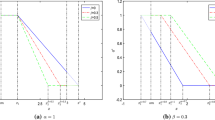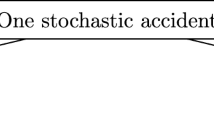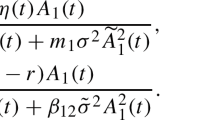Abstract
In this paper, we consider an optimal robust reinsurance problem in a diffusion model for an ambiguity-averse insurer, who worries about ambiguity and aims to minimize the robust value involving the probability of absolute ruin and a penalization of model ambiguity. It is assumed that the insurer is allowed to purchase per-claim reinsurance to transfer its risk exposure, and that the reinsurance premium is computed according to the mean-variance premium principle which is a combination of the expected-value and variance premium principles. The optimal reinsurance strategy and the associated value function are derived explicitly by applying stochastic dynamic programming and by solving the corresponding boundary-value problem. We prove that there exists a unique point of inflection which relies on the penalty parameter greatly such that the robust value function is strictly concave up to the unique point of inflection and is strictly convex afterwards. It is also interesting to observe that the expression of the optimal robust reinsurance strategy is independent of the penalty parameter and coincides with the one in the benchmark case without ambiguity. Finally, some numerical examples are presented to illustrate the effect of ambiguity aversion on our optimal results.



Similar content being viewed by others
Notes
By locally equivalent, we mean the measures are equivalent on \(\mathcal {F}_t\) for all \(t\ge 0\). Note that the stochastic integral can still be defined and has all the usual properties even though the filtrations in our setup are not complete. See, for example, Chapter 1 in Jacod and Shiryaev [27] and Sect. 2 in Bayraktar and Zhang [8].
The existence of such a measure is not guaranteed if the filtration has been completed with respect to \(\mathbb {P}\).
References
Schmidli, H.: On minimizing the ruin probability by investment and reinsurance. Ann. Appl. Probab. 12(3), 890–907 (2002)
Bai, L., Guo, J.: Optimal proportional reinsurance and investment with multiple risky assets and no-shorting constraint. Insur. Math. Econ. 42(3), 968–975 (2008)
Liang, X., Young, V.R.: Minimizing the probability of ruin: optimal per-loss reinsurance. Insur. Math. Econ. 82, 181–190 (2018)
Liu, Y., Ma, J.: Optimal reinsurance/investment problems for general insurance models. Ann. Appl. Probab. 19(4), 1495–1528 (2009)
Liang, Z., Bayraktar, E.: Optimal reinsurance and investment with unobservable claim size and intensity. Insur. Math. Econ. 55(1), 156–66 (2014)
Liang, Z., Yuen, K.C.: Optimal dynamic reinsurance with dependence risks: variance premium principle. Scand. Actuar. J. 2016(1), 18–36 (2016)
Maenhout, P.J.: Robust portfolio rules and detection-error probabilities for a mean-reverting risk premium. J. Econ. Theory 128(1), 136–163 (2006)
Bayraktar, E., Zhang, Y.: Minimizing the probability of lifetime ruin under ambiguity aversion. SIAM J. Control Optim. 53(1), 58–90 (2015)
Yi, B., Li, Z., Viens, F.G., Zeng, Y.: Robust optimal control for an insurer with reinsurance and investment under Heston’s stochastic volatility model. Insur. Math. Econ. 53(3), 601–614 (2013)
Zeng, Y., Li, D., Gu, A.: Robust equilibrium reinsurance-investment strategy for a mean-variance insurer in a model with jumps. Insur. Math. Econ. 66, 138–52 (2016)
Luo, S., Wang, M., Zhu, W.: Maximizing a robust goal-reaching probability with penalization on ambiguity. J. Comput. Appl. Math. 348(2019), 261–281 (2019)
Liang, Z., Bi, J., Yuen, K.C., Zhang, C.: Optimal mean-variance reinsurance and investment in a jump-diffusion financial market with common shock dependence. Math. Method Oper. Res. 84(1), 155–181 (2016)
Luo, S., Taksar, M.: On absolute ruin minimization under a diffusion approximation model. Insur. Math. Econ. 48(1), 123–133 (2011)
Bai, L., Cai, J., Zhou, M.: Optimal reinsurance policies for an insurer with a bivariate reserve risk process in a dynamic setting. Insur. Math. Econ. 53(3), 664–670 (2013)
Li, D., Zeng, Y., Yang, H.: Robust optimal excess-of-loss reinsurance and investment strategy for an insurer in a model with jumps. Scand. Actuar. J. 2018(2), 145–171 (2018)
Liang, Z., Guo, J.: Optimal combining quota-share and excess of loss reinsurance to maximize the expected utility. J. Comput. Appl. Math. 36(1–2), 11–25 (2011)
Zhang, X., Zhou, M., Junyi Guo, J.: Optimal combinational quota-share and excess-of-loss reinsurance policies in a dynamic setting. Appl. Stoch. Model Bus. 23(1), 63–71 (2007)
Zhang, X., Meng, H., Zeng, Y.: Optimal investment and reinsurance strategies for insurers with generalized mean-variance premium principle and no-short selling. Insur. Math. Econ. 67, 125–132 (2016)
Han, X., Liang, Z., Young, V.R.: Optimal reinsurance strategy to minimize the probability of drawdown under a Mean-Variance premium principle. Scand. Actuar. J. (2020). https://doi.org/10.1080/03461238.2020.1788136
Li, D., Young, V.R.: Optimal reinsurance to minimize the discounted probability of ruin under ambiguity. Insur. Math. Econ. 87, 143–52 (2019)
Dassios, A., Embrechts, P.: Martingales and insurance risk. Commun. Stat. Stoch. Models 5(2), 181–217 (1989)
Cai, J.: On the time value of absolute ruin with debit interest. Adv. Appl. Probab. 39(2), 343–359 (2009)
Gerber, H.U., Yang, H.: Absolute ruin probabilities in a jump diffusion risk model with investment. N. Am. Actuar. J. 11(3), 159–169 (2007)
Zhou, M., Cai, J.: Optimal dynamic risk control for insurers with state-dependent income. J. Appl. Probab. 51(2), 417–435 (2014)
Liang, Z., Long, M.: Minimization of absolute ruin probability under negative correlation assumption. Insur. Math. Econ. 65, 247–258 (2015)
Schmidli, H.: Diffusion approximations for a risk process with the possibility of borrowing and investment. Stoch. Models 10(2), 365–388 (1994)
Jacod, J., Shiryaev, A.N. (ed.2): Limit Theorems for Stochastic Processes, Springer, New York (2002)
Grandell, J. (ed.2): Aspects of Risk Theory, Springer, New York (1991)
Liang, X., Liang, Z., Young, V.R.: Optimal reinsurance under the mean-variance premium principle to minimize the probability of ruin. Insur. Math. Econ. 92, 128–146 (2020)
Stroock, D.W.: Lectures on Stochastic Analysis: Diffusion Theory. Cambridge University Press, Cambridge (1987)
Huang, C., Pages, H.: Optimal consumption and portfolio policies with an infinite horizon: existence and convergence. Ann. Appl. Probab. 2(1), 36–64 (1992)
Han, X., Liang, Z., Yuen, K.C.: Minimizing the probability of absolute ruin under the mean-variance premium principle. Working paper, School of Mathematical Sciences, Nanjing Normal University (2019)
Liang, X., Young, V.R.: Reaching a bequest goal with life insurance: ambiguity about risk asset’s drift and mortality’s hazard rate. ASTIN Bull. 50(1), 187–221 (2020)
Zorich, V.A.(ed.2): Mathematical Analysis II, Springer, Heidelberg (2016)
Acknowledgements
The authors would like to thank the anonymous referees for their careful reading and helpful comments on an earlier version of this paper, which led to a considerable improvement of the presentation of the work. The research of Zhibin Liang, Xia Han and Yu Yuan was supported by National Natural Science Foundation of China (Grant No. 11471165). The research of Kam Chuen Yuen was supported by a grant from the Research Grants Council of the Hong Kong Special Administrative Region, China Project No. HKU17306220.
Author information
Authors and Affiliations
Corresponding author
Ethics declarations
Conflict of interest
The authors declare that they have no conflict of interest.
Additional information
Publisher's Note
Springer Nature remains neutral with regard to jurisdictional claims in published maps and institutional affiliations.
Appendix
Appendix
1.1 A. The proof of Theorem 1
Proof
The proof of verification theorem is a modified version of Theorem 3.1 in Luo et al. [11] (also see Theorem 6.1 in Bayraktar and Zhang [8]). Firstly, under the optimal reinsurance policy \(R^*\), the surplus process given in (6) becomes
Let \(\mathbb {Q}\in \mathcal {Q}\) be an arbitrary probability measure with a corresponding probability distortion process \(\phi \). By the Girsanov theorem, \(B^{\mathbb {Q}}_t=B_t-\int _0^t\phi _sds\) is a \(\mathbb {Q}\)-Brownian motion. Then we have
Applying Ito’s Lemma to \(W(\hat{U}^{R^*}_t)\), we have
By Lemma 1, we have \(\tau ^R_{M,N}<\infty \) almost surely for any \(-\infty<M<N<u_s\). Integrating the above equation form 0 to \(\tau ^{R^*}_{M,N}\) and taking \(\mathbb {Q}\)-expectation on both sides, we get
Note that the expectation of the third intergral equals 0 because \(W_u\) and \(\sqrt{\lambda \mathbb {E}\big ((R^*_t)^2\big ) }\) are bounded. Besides, conditions (ii) and (iv) imply that
Therefore, we obtain
We write
Because \(W(u_s)=0,\) combining (69) with (70) and letting \(N\rightarrow u_s\) yield
Since the inequality holds for all \(\mathbb {Q}\in \mathcal {Q}\), we have
The equality in (71) follows from (14) and the fact that \(\tau ^R_M=\infty \) if \(\tau ^{R}_{u_s}\le \tau ^{R}_M\). Note that
Letting \(M\rightarrow -\infty \) in (71), we get \(W(u)\ge V(u).\)
We next prove \(W(u)\le V(u)\). Let R be any admissible reinsurance policy. Under the optimal strategy \(\phi ^*=\phi ^*(R,u)\), there exists a measure \(\mathbb {Q}^*\in \mathcal {Q}\) satisfying \(\frac{d\mathbb {Q}^*_t}{d\mathbb {P}_t}={\varepsilon (\int _0^t\phi ^*_tdB_s)}\), where \(\varepsilon \) denotes the stochastic exponential. It follows from the Girsanov theorem that \(B^{\mathbb {Q}^*}_t=B_t-\int _0^t\phi ^*_sds\). Then the surplus process becomes
Applying Ito’s lemma to \(W(\hat{U}^R_t)\), we have
Integrating the above equation from 0 to \(\tau ^R_{M,N}\) and taking \(\mathbb {Q}^*\)-expectation on both sides yield
Similarly, the expectation of the third integral equals 0 due to the fact that \(W_u\) and \(\sqrt{\lambda \mathbb {E}\big (R_t\big )^2 }\) are bounded. By conditions (ii), (iv) and our definition of \(\phi ^*\), we have
Therefore, we have
Write
Because \(W(u_s)=0,\) combining (74) with (75) and letting \(N\rightarrow u_s\) yield
This hold for any \(R\in \mathcal {D}\), so we have
Letting \(M\rightarrow -\infty \) in (77), it follows from (72) that \(W(u)\le V(u)\). Therefore, we conclude that \(W(u)=V(u)\). Moreover, repeat the analysis above by using \(R^*\) and \(\phi ^*\) in (73) and (74), (73) through (77) hold with equality, and hence
\(\square \)
1.2 B. The proof of Theorem 2
Proof
Suppose that W is a candidate solution to (19). When \(u_1 <u\le u_s\), the function \(W_1(u)=W(u)\) satisfies the following ordinary differential equation (ODE):
Note that (44) is a more explicit version of (34). By letting \(y(u)=W_u\) and rearranging terms, the second order ODE is reduced to
which is in the form of Bernoulli differential equation. Furthermore, setting \(z(u)=1/y(u)\) yields
and thus has the following general solution
from which we obtain
Here, \(C_1\) and \(C_2\) are constants to be determined. When \(-\infty <u\le u_1\), the function \(W_2(u)=W(u)\) satisfies the following ODE:
Along the same lines, one can obtain
where \(C_3\) and \(C_4\) are constants to be determined. By using the boundary conditions in (39) and the smooth-fit conditions, that is,
we get
Using these results and Lemma 5, we can show that W equals the right-hand side of (43). In particular, due to the fact that \(C_1\) satisfies conditions (42), it is straightforward to show that W is a non-increasing function with bounded first derivative.
Besides, because of \(\eta -\beta _1^*(u_1)=-\beta ^*_2(u_1)=0,\) it is not difficult to verify that \( W''_1(u)|_{u=u_1}= W''_2(u)|_{u=u_1}.\) Therefore, the function W satisfies all the conditions of Theorem 1. As a result, the probability of absolute ruin V(u) is given by (43), the optimal robust reinsurance strategy is given by (45), and the optimal probability distortion function is given by (46). \(\square \)
Rights and permissions
About this article
Cite this article
Han, X., Liang, Z., Yuen, K.C. et al. Minimizing the Probability of Absolute Ruin Under Ambiguity Aversion . Appl Math Optim 84, 2495–2525 (2021). https://doi.org/10.1007/s00245-020-09714-y
Published:
Issue Date:
DOI: https://doi.org/10.1007/s00245-020-09714-y
Keywords
- Absolute ruin probability
- Ambiguity aversion
- Mean-variance premium principle
- Per-claim reinsurance
- Robust optimization




